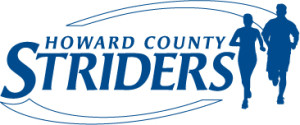RRCA Club Challenge 10M
1999 Club Challenge Overall Results
1999 Club Challenge Team Results (Summary)
1999 Club Challenge Team Results (Women)
1999 Club Challenge Team Results (Men)
1999 Club Challenge Team Results (Coed)
The Strider men’s racing team crushed the competition at the Annual RRCA 10-Mile Challenge race last Sunday and more than made up for a poor showing by a women’s team decimated by illnesses and absences. When the smoke cleared, the Strider combined team had compiled an overall total of 823 points, well ahead of the second-place Baltimore Road Runners who had 1073 points (low score wins).
Howard County’s Mark Gilmore seized the early lead in the race and never looked back. “I never had to look back,” he said, “because I could see my competition at the turn-arounds.” By four miles, Mark had a lead of 100 yards, and by six miles the race was his. He finished over a quarter mile ahead of the second place runner with a time of 53:39. Gilmore’s effort set the tone for the Strider Men’s Racing Team, which overwhelmed teams from Baltimore, Montgomery County, Annapolis, and DC. Striders Dave Berardi, Tony Basile, Jon Shuskinsky, and Faisal Hasan followed the lead of Gilmore and all broke into the top finishers (and all of them broke 58 minutes, too). The Strider men enjoyed a point total of 571, nearly 400 points better than the nearest men’s team (from Baltimore).
The story in the women’s team race was exactly the opposite, however, as illnesses and absences decimated the Strider Women’s Team. Baltimore’s Denise Knickman, an Olympic Marathon trials qualifier and Baltimore Road Runner Women’s Runner of the year for 1998, easily won the women’s overall race (1:02:55) and lead the her women’s team to the women’s team championship. Without Strider women such a Bea Marie Altieri and Vanessa Cox, she confessed that the race “was not as competitive as in years past.” The Strider women sank to fourth place behind teams from Montgomery County and DC as well as Baltimore. Pat Keating, the top Strider woman, ran with the flu and still managed to place eighth among the women (1:08:41).
The Strider Men so dominated the scoring, however, that the local Striders won the overall team challenge by a significant margin of over 200 points. The top 19 men and the top three women on each team scored, as Howard County won its third Challenge Race in as many years. The overall men’s and women’s winners and each team won an engraved pewter plate, but there were no other awards. “If you finished second, you lost,” explained race director Paul Goldenberg. After the Challenge awards were preents, RRCA Eastern Representative Jim Adams distributed awards to winners of the 1998 RRCA Championship Series.
As usual, the Annual RRCA Challenge 10 Miler took place on the hills of Clary’s Forest Neighborhood in Columbia, MD, and most runners had more trouble with the hills than the seasonably cold temperatures. The out-and-back course visited several steep uphills twice. “If you didn’t like the hills the first time, you got a second chance,” said one runner. The 30F temperatures did not seem to bother the runners as all. “It was only a two-gloves day,” said Jim Moreland, who also ran in shorts and a t-shirt.
A total of 341 of runners turned out for seven RRCA club teams on the cold, clear February morning, many of them registering at the last moment. For the first time in a decade, the DC Road Runners Club posted a full racing team in the Challenge. Organized by team captain Mark DeAngelis, the group indicated they had been “re-invigorated by team racing.” In addition, for the first time a “Goat Runners” team from the U.S. Naval Academy participated but did not score because of their non-affiliation with the RRCA. Had the goats been an official team, they would have done well because two of them placed among the top ten.
The Howard County Striders host the 10 Mile Challenge every year, using the Howard Community College as the start and finish. Striders coned much of the 10 mile course, and Howard County police imposed a strict traffic control to ensure runners’ safety.
by Jim Carbary
